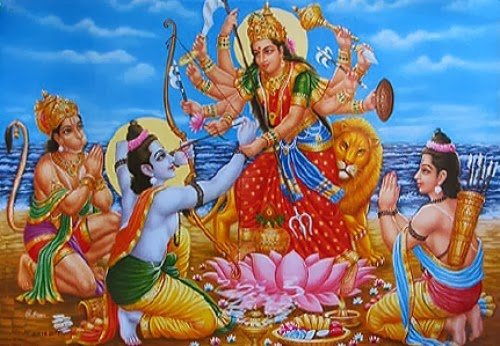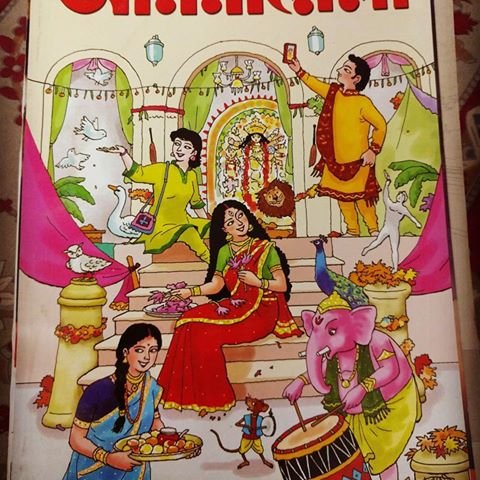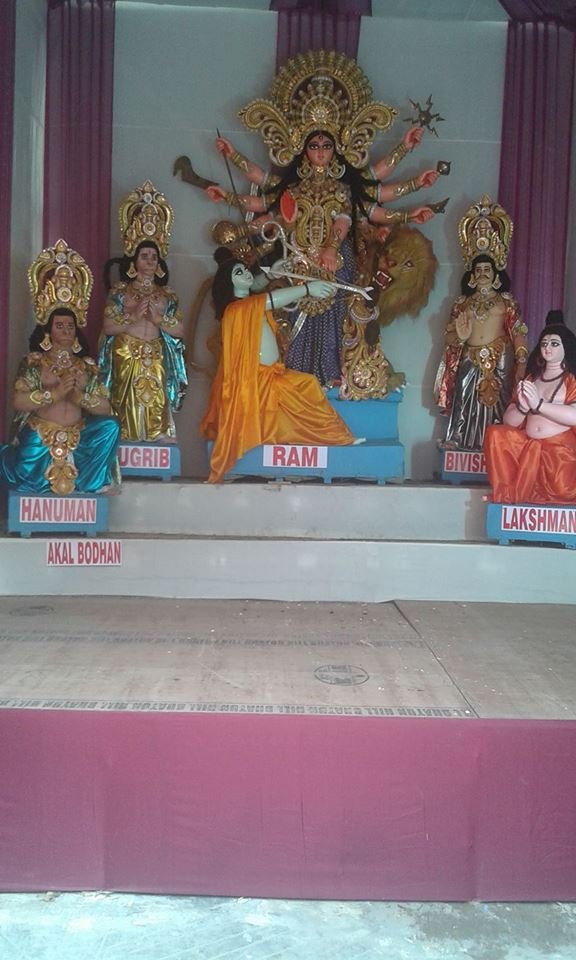A new trend is visible in Kolkata in the organizing of the idols of Devi Durga. A few Puja Committees have chosen to depict the Goddess in the context of the Untimely Invocation (Akaalbodhan) of Her by Ramchandra on the eve of his battle with Ravana. Ramchandra sought a special blessing from the Devi so he could defeat Ravana, a powerful warrior.

To ask for this special favour, Ramchandra invoked Devi Durga in Autumn instead of Spring, the regular season of Her worship. Since the annual Durga Puja festival of Bengal is also held in Autumn, this new trend identifies Ramchandra’s Akaalbodhan’s timing as the time for the yearly worship of the Goddess.
The Bengali perception of Durga
This narrative is very different from the one that we Bengalis have been used to for hundreds of years. We had imagined Devi Durga as Parvati/Uma, the daughter of the King of the Himalayas and his wife Menaka, and the time for Her yearly worship as the time of Her coming for her annual three day visit to Her parents with Her children in tow. Parallel to this story of familial affection, separation and reunion, we also imagined her as the Goddess Chandi/Shakti responsible for vanquishing Evil in the form of the demon Mahishasura and reestablishing Peace and Goodness in the world.

This showcases a unique Bengali talent that is comfortable with fusing respect for divinity with everyday familial affections and emotions. To paraphrase Rabindranath Tagore, Bengali religious culture has always discovered divinity in their loved ones and worshipped their loved ones as divinity.
Among a few other places, the new trend can be seen in the Puja being held in Peary Charan Sarkar Street near College Street (see photo below). In a departure from the generally accepted version of Durga riding a lion while slaying the demon Mahishasura with her four children, Lakshmi, Saraswati, Kartik and Ganesh standing around (confident in their belief that their mother the Goddess doesn’t need any help from them), here we find Durga appearing alone before Ramchandra with neither a demon to slay nor any children encircling her. There is neither a familial context nor any allusion to her role as the incarnation of Shakti to vanquish Evil and reestablish the rule of the Good in the world. Instead of her children, we find standing around her, along with Ramchandra, the devout Hanuman, the monkey King Sugrib, Ramchandra’s brother Lakshman and the treacherous brother of Ravana, Bibheeshon.

As is obvious from the photograph, the organizers were only too aware of making a departure. They had taken the pain to paste the name of each of the secondary idols so the ordinary viewer doesn’t get confused about their identities and the meaning of the scene as a whole. The viewer was being clearly told: This is a different Durga.
Is it merely coincidental that we find this trend emerging when the Bharatiya Janata Party (BJP) is making a very strong bid to capture power in the state of West Bengal in the general election to be held in 2019 or that the Peary Charan Sarkar Street Puja is just two steps away from the central office of the BJP in Kolkata? We cannot offer any definitive answer, but there is no harm in making some educated guesses.
A Hindu nation deserves a new version of Durga Puja
The political agenda of the BJP, among other things like development and cleanliness, is to build up a Hindu nation where a uniform Hindu culture will be accepted and celebrated by all Indian citizens regardless of their linguistic and historical diversities. It therefore logically entails the creation of an “authentic” model of Hindu culture identifying a few religious and puranic texts as the sole source of knowledge of this timeless culture. One such puranic text is the epic Ramayana which, claims the ideologues of the party, is “real history”. The other, more along the line of moral philosophy, is called the Manusmriti.
Now “authenticity” always abhors “fuzziness”. The Brahmanical model of Hindutva finds this Bengali cultural tradition of fusing the aura of divinity with their everyday lives an example of “fuzzy logic”. The eastern region of India that contains the modern state of West Bengal has historically been on the fringes of the Brahmanical and rigidly caste-based social structure of Northern and Central India and has all along had a very syncretistic streak where – unlike in Northern and Central India — many local Gods and Goddesses (Shitala, Manasa, Shoshthhi, Dhammo Thakur to name a few) were continually brought into the fold of “Hinduism” to radically alter the contours of the religious culture of the region.
One of the many political strategies of the BJP has been to “amend” this fuzziness in Bengal’s religious space by streamlining it according to their ur-text, the Ramayana. To tell the narrative of Devi Durga’s coming down to earth as it is told in the Ramayana is to be able to coopt the spirit of the most important cultural-social festival of Bengal into the fold of authentic Hinduism of the Ramayana. The BJP ideologues want to argue that the Bengali narrative of the daughter’s home-coming is the wrong narrative for this season. The new narrative is also a political statement: The authentic Hindu way to worship Goddess Durga is to invoke the (his)story of Shri Ramchandra’s untimely invocation of the Goddess. The daughter’s home-coming is a bastardized narrative.
Hinduness vs Bengaliness
Among the BJP’s repertoire of political symbols one of the most significant one is the centrality of Ram as a historical as well as a divine figure (much like Jesus Christ). Declaring the pluralistic Bengali Durga Puja as a kind of mild heresy and replacing it with a Ram-centred narrative is the BJP’s political strategy to consolidate the support of those Bengali Hindus to whom their Bengali cultural identity is subservient to their identity as Hindus. The goal of the BJP is to bring alive the dormant hostility of some Hindus towards the sizable Muslim population of the state by unifying the Hindus around their “Hinduness” rather than their “Bengaliness”. What can be more effective than successfully altering a cultural festival into a religious one? This will weaken the secular civil society dimension of the Durga Puja and make it into an assertion of Hinduness.
This is then the challenge for those who are Bengalis before they are Hindus or Muslims: How to keep alive the slogan “Durga Mai ki Jai” and “ashchhe bochhor abaar hobe” and not let them be displaced by “Jai Shree Ram”. We don’t want the rigid caste-based discipline or the patriarchal dominance of the mythical Ramrajya. Once again Rabindranath Tagore comes to our rescue in stating our secular democratic identity as opposed to a religious communal one: Each one of us is a king in this kingdom of our King.
The author, Dulali Nag, teaches at the Indian Institute for Social Welfare and Business Management, Kolkata
The information, ideas or opinions appearing in this article are those of the author and do not reflect the views of ScoopWhoop.

















